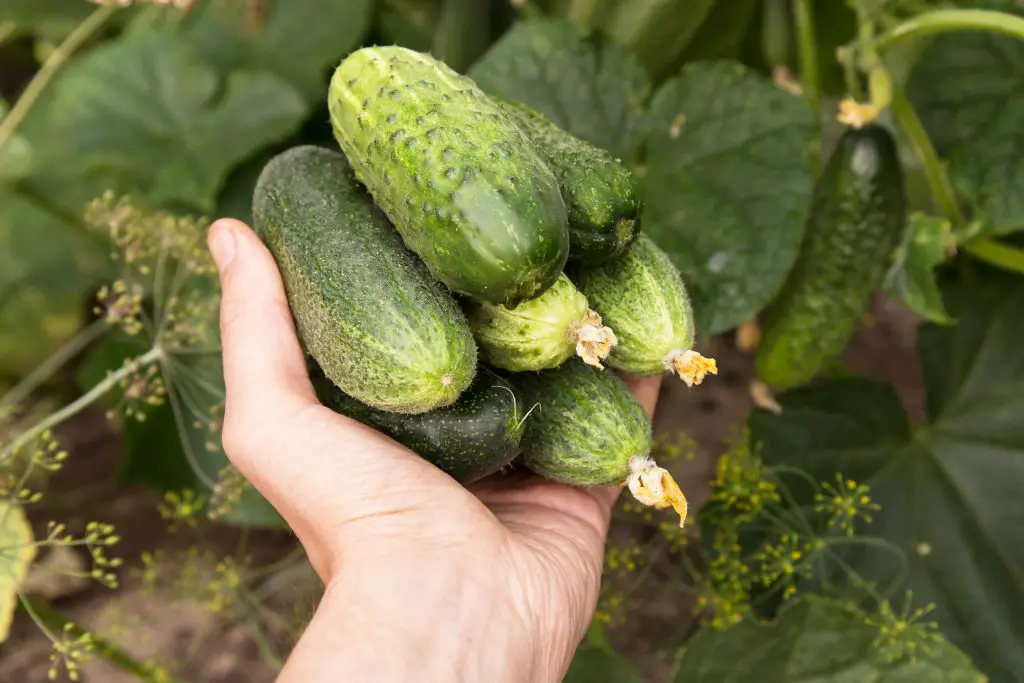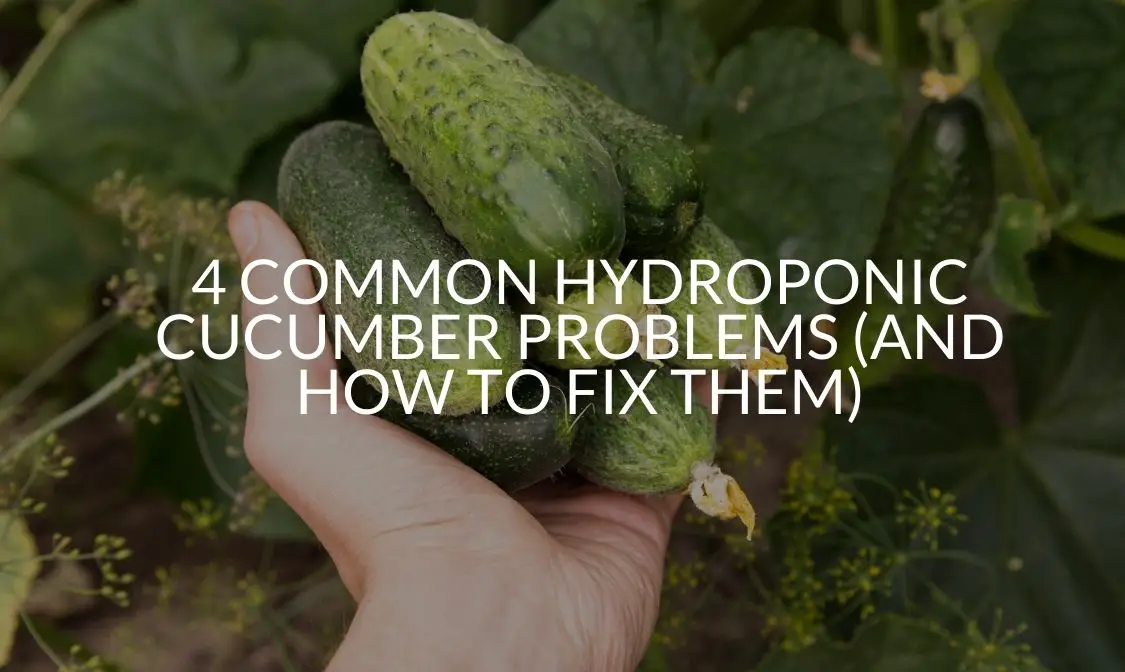Hydroponic cucumber plants are a great way to grow cucumbers during seasons not conducive to growing or in climates unfavorable to cucumber planting. However, like outdoor gardens, greenhouse gardens have their fair share of problems too.
In this article, we will address some of the common hydroponic cucumber problems including fungal diseases and insect pests. We will also give you pointers on the best way to pollinate your hydroponic cucumber plants and the optimal pH to grow them in allowing maximum yield.
What Are Some Common Hydroponic Cucumber Problems? (And How Do You Fix Them?)
Problem: Powdery Mildew
Powdery mildew is a white fungus that will grow on the leaves, flowers, and fruits of your cucumber plant. It survives best in warm climates that provide high humidity like that of your greenhouse and especially grows during the warm days and cooler nights of the late spring to early summer.
It will not directly kill your cucumber plant, but it will steal the nutrients and water intended for your cucumber plant causing it to grow slower, become weaker, and eventually not produce any fruit.
Solution
Organic fungicide with sulfur as the main active ingredient can help prevent powdery mildew. There are also certain varieties of greenhouse cucumber that are bred to be more resistant to the fungus, so planting these may be more sustainable. Ensure plenty of airflow among the vines and leaves by appropriately spacing out cucumber plants to reduce the relative humidity.
If your cucumber plant is already showing signs of powdery mildew, be sure to prune any diseased leaves or vines and disinfect shearers after use so as not to spread the disease to any other parts of the plant. There are also homemade solutions that can be applied to your cucumber plant with spray bottles.
Mixtures include baking soda or potassium carbonate, soap, and water; or milk and water. Neem oil can also be added to any of these combinations for additional fungus-killing power.
Problem: Gummy Stem Blight
Gummy stem blight is another fungus that infects the leaves and stems of the cucumber plant causing wet black lesions on leaves and splitting open stems to ooze a reddish-brown gummy substance. If left untreated, the blight can travel to the fruit of the plant and develop into black rot.
Small black dots which are the reproductive vessels of these fungi can be observed on the cucumber plant and any water-soaked area can quickly rot out, especially on the cucumber fruit. This disease is prevalent during periods of high heat and humidity and spreads through infected soil and seeds.
Solution
Strong commercial fungicides applied during prime gummy stem blight season or when the leaves of the cucumber plant are beginning to reach full size are the best way to prevent your cucumber plants from contracting the disease. Also, applying insecticides and pests such as aphids and beetles which nibble through leaves and stems, introducing easy access for the fungus to establish itself.

Problem: Two Spotted Spider Mites
Two-spotted spider mites are pests that thrive in hot, dry environments. They can negatively affect the yield of your cucumber plants by preventing maximum photosynthesis. These mites appear as minuscule spots on the underside of the plant’s leaf and can cause yellowing of leaves, necrosis of plant tissue, and loss or slow growth of plant leaves altogether.
If they infect the fruit of the cucumber plant, the outer skin will become rough like sandpaper. It’s important to control the spread of two-spotted spider mites as soon as possible because they can multiply up to seventy times in a seven-day period if conditions are optimal for their breeding and growth.
Solution
There are several ways to get rid of two-spotted spider mites including applying miticides, scrubbing cucumber plant leaves with insecticide soap, and introducing predatory mite species that will only kill the pesky spider mites and not harm the cucumber plant. Applying miticides as a preventive is helpful as well as choosing a variant of cucumber such as the Japanese Taurus which is more resistant to two-spotted spider mites.
Problem: Broad Mites
Broad mites feed and lay their eggs on the underside of cucumber leaves. They inject a toxin into the leaves when they feed on it causing the plant shoots to become distorted, the leaves to curl downward, and the fruit to crack. Broad mites hatch and thrive in hot, humid conditions, but may still be a pest during cooler conditions although they take longer to develop.
They are extremely small thus being hard to detect and can be spread from plant to plant through the air, plant to plant contact, or via tools and gardener’s hands which touch infected plants.
Solution
Once established, broad mites can be very difficult to get rid of. Miticides may help, but broad mites tend to be resistant to most mite-fighting chemicals. Removing infected plants completely from the greenhouse will help prevent the spread of the mites and ensuring that cucumber plants are properly free of weeds that may encourage mite transmission is essential.
Predatory mites have been shown to be helpful in ridding cucumber plants of broad mites and introducing predatory mites before conditions are optimal for broad mite breeding may help prevent the establishment of broad mites in the first place.
FAQs
How Do You Pollinate Hydroponic Cucumbers?
To pollinate your hydroponic cucumber plants, you will need to identify the male and female flowers – male flowers are usually smaller, bloom first, and have visible pollen powder within them. Use a Q-tip or small paintbrush to gently collect pollen from the interior of the male flower. Fertilize the female flower by lightly depositing some of the pollen in the interior of the female flower.
What Is the Best pH for Hydroponic Cucumbers?
The best pH to keep your soil for hydroponic cucumbers is an optimal acidic 5.5 to 6.0. This range allows the cucumber plants to access the most amount of nutrients in the soil for peak growth. It’s best to check your soil pH levels daily to ensure this range is sustained and use water that matches the optimal pH as well.
Recap
Hydroponic cucumber plants can be a very efficient and convenient way to grow cucumbers, but there are issues that may arise in your cozy little greenhouse. Due to conditions of high heat and humidity, fungal diseases such as powdery mildew and gummy stem blight and insect pests such as two-spotted spider and broad mites can severely impact your cucumber plants’ ability to grow and produce fruit.
Despair not though, for there are ways to prevent (and treat if your plant has already succumbed) these common cucumber plant issues. Most of the time, the use of fungicides and miticides can help solve these issues.
Keeping your cucumber plants in optimal conditions such as the required soil pH and managing pollination can also help you ensure maximum fruit yield. Just remember to be vigilant and curb any issues as soon as they arise instead of having to clear out dead and diseased plants and starting all over again from square one.







